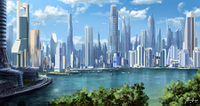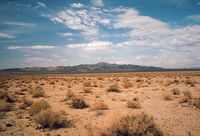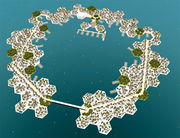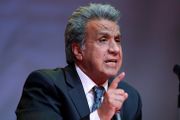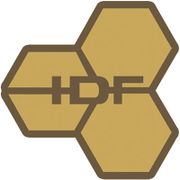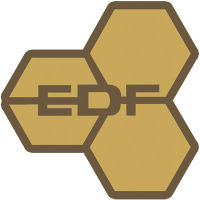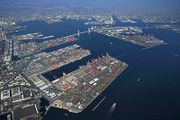Difference between revisions of "Nation/Free Syllvin"
Free Syllvin (Talk | contribs) |
Free Syllvin (Talk | contribs) |
||
| Line 216: | Line 216: | ||
==Economy== | ==Economy== | ||
| − | Free Syllvin is a manufacturing-driven economy. The local service market is well developed but rarely sees foreign customers, while Syllvan-made goods are used throughout the world. The economy has traditionally been characterized by fluctuating growth, high levels of innovation, and low inflation. Unemployment averages between 2 and 4 percent annually, with the largest contributing factor being medical disabilities. As a consequence, economic growth has slowed over the past decade and given way to an increasingly prevalent socialist welfare system. | + | Free Syllvin is a manufacturing-driven economy. The local service market is well developed but rarely sees foreign customers, while Syllvan-made goods are used throughout the world. The economy has traditionally been characterized by fluctuating growth, high levels of innovation, and low inflation. Unemployment averages between 2 and 4 percent annually, with the largest contributing factor being medical disabilities. As a consequence, economic growth has slowed over the past decade and given way to an increasingly prevalent socialist welfare system. Per-capita PPP stands at $39,926, making Free Syllvin one of the wealthiest nations in Gondwana. |
| + | |||
| + | Free Syllvin has an enormously diverse manufacturing sector, which started in the 1920's with coal, steel, lumber, and woodwork. It has since diversified into several dozen categories, the most prominent among them being sea and aircraft, photovoltaics, electrical systems, industrial machinery, nuclear power, plastics, and public transportation. The largest area of Syllvan manufacturing is military equipment. Due to the historic nature of warfare and a slew of lax legal standards about taxing, purchasing, and owning weapons, Free Syllvin is both the birthplace and adopted home of many arms manufacturers. | ||
| + | |||
| + | Banking and investment also plays a large role in the Syllvan economy. Banks are heavily regulated by the state, and as a result there are a large amount of privacy regulations that make Free Syllvin an attractive tax haven. Substantial amounts of revenues of local and international corporations are channeled through the Syllvan financial system every year, so much that up to 7% of the Syllvan economy is bolstered by the operating fees that banks charge for handling this money. The investment climate in Free Syllvin has experienced a 8% growth over the past two fiscal years, as laws concerning international corporations are relaxed. The city of Kendring, being the largest port in Eastern Gondwana, has seen the largest influx of foreign companies; two insurance firms, a bank, five shipping companies, and three cruise tours have opened regional offices in 2018. | ||
| + | |||
| + | Free Syllvin has a small agricultural sector, mostly dedicated to supplying food for the local population. Focused around the eastern area of Syllvania, farms never reach more than 50 acres. The staple crops grown are the ''Sore'' apple cultivar, ''Noreno'' oranges, ''Oroje'' pears, beets, corn, ginger, and oat. Other crops include millet, sugarcane, tea, coffee, flax, and hemp. | ||
| + | |||
| + | Fishing is an important supplement market for Free Syllvin. Possessing a unique exclusive economic zone that is shaped by the Greater Allas Boundary, the nation has approximately 1.4 square million kilometers of ocean to fish in when factoring in the inland sea of Lake Cirrel. Small communities in Syllvania commonly depend entirely on fishing, and large ports in the Confederacy host significant fleets of trawlers and trappers. In the largest cities, aquaculture has become a common way to produce food for citizens locally. The most prevalent fishieries are in the Central Concordian Ocean, south of Tonk, and in the Aravnian Sea between the Confederacy and the mainland. In total, over 70 million tonnes of sealife was caught in 2017 with another 20 million produced from aquaculture facilities, generating $167 billion in exports. | ||
===Government Oversight=== | ===Government Oversight=== | ||
Revision as of 01:23, 26 June 2018
| This page is a work in progress by its author(s) and should not be considered final. |
| The Confederate Islands of Free Syllvin Adante Illa Farvin Sillwen
|
||||
|---|---|---|---|---|
|
||||
| Motto: "Best Way Forwards" | ||||
| Anthem: "Sail On Higher" | ||||
| Capital and largest city | Syllvan Center | |||
| Official languages | Avannian, Island Common | |||
| Demonym | Syllvanian | |||
| Government | Tricameral Parliamentary Republic | |||
| - | Chairman of the Conclave | Constantine DeMarc | ||
| - | Speaker for the Assembly | Cyro Valle | ||
| - | Speaker for the Commons | Ellie Montus | ||
| Legislature | Syllvan High Senate | |||
| - | Upper house | The Conclave | ||
| - | Lower house | The Island Assembly & The Commons | ||
| Formation | ||||
| - | Establishment as a Kingdom | 4 January 1650 | ||
| - | Valandar Reformation | 7 April 1919 | ||
| - | Finagle's War | 22 March 1932 | ||
| - | Island Revolution | 25 October 2016 | ||
| - | Water (%) | 31% | ||
| Population | ||||
| - | 2016 estimate | 69,025,731 | ||
| - | 2016 census | 67,143,097 | ||
| GDP (PPP) | 2018 estimate | |||
| - | Total | ΣD 3,131,780,000,000 | ||
| - | Per capita | ΣD 45,371 | ||
| Currency | Syllvanian E-dollar (ΣD) (SED) |
|||
| Time zone | Syllvan Island Time (UTC -2) | |||
| Drives on the | right | |||
| Calling code | 407 | |||
| Internet TLD | .sv | |||
The Confederate Islands of Free Syllvin, known nativley as Adante Illa Farvin Sillwen ( lit. The Free Confederacy of Forested Isles), and most commonly referred to as Free Syllvin, is an equatorial nation that enjoys a high standard of living and a comfortable tropical climate. It is comprised of 41 territories spread across a volcanic-coral island chain in the South Concordian Ocean, as well as 11 territories in eastern Gondwana. The two areas are separated into Sectors known as "the Confederacy" and "Syllvania," respectively. While also laying claim to some 237 other small landmasses in the area, Free Syllvin only maintains a passing presence on them due to their usage as resource mines or military posts. The largest island, Valandar, has almost a third of its landmass covered by the capitol city of Syllvan Center, which is the largest city in the nation and the main cultural and commercial center. Free Syllvin shares borders with the Mondoni Badlands and Antratis to the north, the Daccic Republic to the west, and Frentia to the south.
The ecosystems of Free Syllvin are widely diverse, with the most-common being tropical rain-forest and the second most-common tropical savanna. Several inland territories have grasslands and tropical deserts covering their interiors behind mountains. Salt marshes and mangrove swamps form the outer regions of most populated landmasses. The archipelago hosts a wide assortment of coral reefs and cays as well. The highest point is Cormin Peak, 1712 meters above sea level, with an average height of 234 meters above sea level. Syllvanians are conscious of their environment, with 35 ecologically protected parks and preserves spread around the nation. Several species can only be found in Free Syllvin. The Stepsister islands are the only habitat of the Reef Deer (kerwus farvil Syllvanius) and the Bill (piskus taberkulnaceuvishekerllionum) has only been recorded in the Greater Allas Boundary.
Free Syllvin is a traditional nautical power, boasting a rich history of pre-industrial societies. The sight of fishermen and pearl divers hailing from the ancestral home of the Syllvanians was a common sight in the island chains. The first society to arise in the area were the Ado people, a skilled group of industrial inventors who pioneered many things for their local archipelago, including the sail. They were wiped out by the cannibalistic Gynn, who were in turn wiped out in a tidal wave. The foundations for what would become Syllvin Center were laid by what is known as the Kwun people in 800 CE.
First coming into its own as a proper nation state at around 1650 CE, with the formation of the Kingdom of the Islands and the Coast, the modern Free Syllvin is a leader in law enforcement, public transport, and defense. Its income per-capita is consistent within 30,000 E-dollars of the highest and lowest levels of society thanks to extremely tight income tax on the top 10%. Private corporations are effectually illegal, with company boards being populated by officials from an associated committee in the Syllvanian legistlature. Free Syllvin is considered a post-information state, with heavily networked infrastructure and technological prevalence. The nation's primary exports are military equipment, technology, and sea-craft.
Contents
History
Early Inhabitants
Archaeological records show that the archipelago was inhabited as early as 300 CE. However, the most comprehensive and intact signs of native inhabitants date to 535 CE. Rock carvings on the islands of Valandar and Lipock contain records of a tribe known as the Ado, who developed a fishing society with small stilt villages spread out across the northern cays. Carvings on basalt pillars indicate that the Ado used a crude form of sailing and navigation to travel, making them the first Syllvan society on record to do so. They are remarkable in other aspects such as practicing a form of writing, having a grasp of trade and bartering.
The Ado people were competent sailors and divers, but were unaccustomed to conflict due in part to the lack of any other tribes in the area. A structured hierarchy also seemed to prevent internal disputes. This left them easy prey for the nomadic Gynn tribe, who can be traced to the Emoro Straights. Records from both the Ado and Gynn detail a short, brutal conflict in which the stilt villages of the Ado were burned, their religious sites destroyed, and people eaten. The only remains of their society are in the form of sunken canoes and basalt carvings.
The Gynn, seemingly violent and cannibalistic from the few ritual artifacts they left behind, remained the dominant inhabitants of the islands until around 612 CE. Geological indicators of a tsunami can be found pertaining to this event, as well as the disappearance of relics with the design of Gynn culture at around this time. The nomadic nature of the tribe ensured few permanent settlements, and there is little protection from a tidal wave on open water. With the Gynn gone, the archipelago would remain uninhabited for another hundred and fifty years.
The Kwun people, who are regarded as the true founders of Free Syllvin, first appeared near 800 CE. Their establishment of a village on the Rillin Bay is the first archaeological sign of their existence, so it is likely they emigrated from the area of Butan to the northwest. The Kwun were a cautious and careful people, and detailed translations of pictographs reveal a deep mistrust of outsiders. Their village, as it expanded, was fortified and restructured to prevent outside access. Many anthropologists believe that the xenophobia and love of fortifications passed from the Kwun to the Syllvan peoples.
Monarchy
The Succession Wars
Stabilization
Modern Era
Free Syllvin currently operates a social-consciousness government, which states that it's goal is to view issues from the perspectives of the people. While, phasing out of a massive military-industrial complex is difficult, the High Senate is taking steps to once again diversify the Syllvan economy. With much of the Confederacy urbanized or otherwise heavily developed, there is a strict and ever increasing set of environmental regulations to preserve the habitats and ecosystems that are spread around the nation.
Geography
The Syllvan islands developed as the tectonic plates shifted, exposing a volcanic hotspot. This hotspots is still active to the north of the nation and there is a small ethnic group from the islands who make pilgrimages there. The island it is located on currently does not fall within Syllvanian influence. The oldest and southmost of the islands in the chain, Daesan, is estimated to be 17 million years old, and the largest and northernmost, Valandar, is just under 500,000 years old. There are several dormant volcanic peaks throughout the chain, but each has been inactive for at least 3 million years. The rock content is mostly silica, with large deposits of basalt throughout the area. The volcanic islands of Free Syllvin are each their own territory, with 12 islands larger than 1,000 square kilometers and 29 smaller. Along the eastern side of the island chain, there is a long series of barrier islands, atolls, and coral cays that are known as the StepSisters.
This archipelago is built upon the Greater Allas Boundary, an extensive reef ecosystem that extends 1,800 miles north-south and 200 miles east-west. Because of this natural barrier between the island chain and the ocean proper, the only ways to access the Confederacy and most of Syllvania from the sea with large ships is to travel between either the northern or southern gap between the islands and the mainland. All other attempts will result in becoming beached on the reefs, which will not only scuttle a ship, but incur severe fines from the Syllvan government. All of the islands of the Confederacy and the Stepsisters enjoy a warm, tropical climate year round. During the periods of storms, however, the smaller landmasses have a high risk of flooding.
The territories of Syllvania are separated into three distinct ecosystems. The coastal Carrius, Penael, and East Larrica are subtropical forest, while Karaktan and Gerrima are mountains. The midland areas of Visthus and Sencan are dominated by mountains, while Anneun is covered in tropical rain-forest. The inland territories of Dacceron and Polmor are rain-shadowed regions.
Metropolitan Territories
Due to the Confederacy being the historical and cultural home of the Farwe ethnic group, it is home to the majority of their population, and as a result, the largest number of individual urban conglomerations in the nation. 14 of the islands are completely covered with city-sprawls and land reclamation projects in order to provide living space for the large populations. While a large portion of the population lives in and on the Greater Metropolitan Territory of Valandar, there remains a premium on living space throughout the archipelago. Because it has been viewed as cheaper to continue building high rises and reclaiming land than creating entire new cities on the mainland, this issue may perpetuate ad nauseum.
Climate
The climate of Free Syllvin varies by region, due to differences in altitude and, with some extent, proximity to the ocean. It is generally mild year round in the central highlands, with a humid subtropical climate in the lowlands. The islands and coast are generally tropical rainforest. In the western lowlands, subtropical desert expands out past Lake Cirrel due to rainshadowing.The coastal lowlands in the eastern part of Free Syllvin are typically warm with temperatures in the region of 25 °C (77 °F). Coastal areas are affected by ocean currents and between January and April are hot and rainy.
The weather in the regions further inland is consistent with that of a subtropical highland climate. The areas east of the Gedian Mountains is subject to some ocean breezes that cool the area, but west of the mountain range has no such wind patterns. In the tropical territories, the average temperature during the day is 78 °F (26 °C), which generally falls to an average of 50 °F (10 °C) at night. The average temperature annually is 64 °F (17.8 °C). In the highlands areas, the average temperature is 61 °F (16 °C) during the day and drops to an average of 47 °F (8 °C) at night. The average annual temperature is 55 °F (13 °C). In the subtropical desert regions, the average temperature can climb up to 89 °F (31 °C). At night, it can drop to an average of 43 °F (6 °C). The dry season (summer) runs from June to September and the wet season (winter) is from October to May. As Free Syllvin is below the equatorial line, June to September is considered to be winter, and winter is generally the dry season in warm climates. Spring, summer, and fall are generally the "wet seasons" while winter is the dry (with the exception of the first month of fall being dry).
Modular Aquatic Population Limit Extenders
A project that Free Syllvin researched and engineered with assistance from the Oan Isles, the M.A.P.L.E. project is intended to be a semi-permanent or permanent residence for communities that have been destroyed by coastal flooding. A complex is made up of a number of M.A.P.L.E. platforms that have interlocked at the corners, which can number anywhere from two to several dozen. Each platform is based upon the semi-submersible hull construction used in oil platforms, and has its own power generation and propulsion systems used to transport the platform and design different complex configurations. The project was completed in early 2018, with three massive construction yards in Tonk, East Larrica, and Aquitar set aside for the exclusive production of M.A.P.L.E. platforms.
In contrast to the original project, M.A.P.L.E.s are singular units that can be configured into a number of different roles, as opposed to a single larger platform that would have to be designed and built all at once. There are currently 17 different configurations for a platform, with the primary 3 being power generation, residency, and hydroponics. A typical residence platform can house upwards of 1,600 people in high-density condominium structures. Most accommodations are not much different than a small hotel room or apartment flat. Occupants of living space are required to either pay a monthly rent or work in the complex in a role that keeps the platforms or facilities functioning. The power platforms are divided into solar, hydro, and wind power. Each turbine on the wind platform can generate up to 500,000 kilowatts a year, totaling 50 gigawatts, while the solar platforms can generate more that 20 gigawatts a year. Hydro platforms are able to have structures built on their upper surface thanks to the power generation equipment being located within and underneath the platform, but have a drastically reduced capacity, only generating 420,000 kilowatts a year. The platforms are equipped in such a way that excess energy is stored in capacitors across each unit, and can be dispensed to power the integrated boats and helicopters that are built into certain models. The hydroponics platforms can each individually provide food for approximately 2,000 people, depending on the crops grown. They are primarily used as a stopgap measure to supplement food supplies, which are imported from other locations or are harvested by the complex's occupants.
A complete list of the types of platform configurations is as follows:
- Complex Command/Control
- High density residence
- Commercial/Shopping
- Security
- Helicopter hanger
- Recreational facility
- Hydroponics facility
- Medical facility
- Low density residence
- Solar power
- Wind power
- Hydro power
- Food processing facility
- Air defense facility
- Bridge anchor
- Parkland
- Ferry dock
Each platform requires a crew of between 35 to 120 to operate. Certain platforms need to be crewed by specialty personnel such as doctors or military operatives.
Free Syllvin maintains the option of any entity purchasing however many platforms they like, so long as they have the funds to buy it and the personnel to crew it. If an interested party wants to commission a custom-built platform, they can submit a detailed plan for the construction and will be billed the cost of construction as well as assembly. The primary target for the sale of the M.A.P.L.E.S is the type of small coastal or island nation that is running out of room for living space or infrastructure. The cost for a single platform is 80 million Kiribs, while a full complex can cost upwards of 25 billion.
There are currently four M.A.P.L.E. complexes: the prototype, consisting of smaller pentagonal platforms, is located in the southern Confederacy between Meluton and Sudeton, a complex of thirty-five platforms given to the Oan Isles as thanks for their assistance in completing the project, a complex of seventy-five platforms donated to the PKFU under Syllvan supervision, and a complex of ten currently in construction.
Government
Administration
Free Syllvin is currently led by a three-house parliament. The upper house, known as the Conclave, consists of 52 Councilors elected from each of the major territories. The role of Chairman, essentially the head of state, rotates positions every 2 years based upon an interior vote, and the Councilors are re-elected by their constituents every 5 years. Each is the head of a certain department within the government, such as Commerce or Agriculture. They serve as a quasi-executive branch, voting upon resolutions approved by the Island Assembly, and enacting edicts themselves.
The "lower houses" are the Commons and Island Assembly, though they each have separate functions that make them equal. The Island Assembly is the de-facto legislative branch, and deals with passing, altering, and repealing law. They are composed of 106 delegates, 2 from each territory. The delegates are appointed by the preceding delegate, selected from a list of candidates elected by the people of the territory. The Commons is made up of 312 officials from around the nation; each territory is allotted 6 elected representatives. They represent a check on the powers of the other two, debating laws and regulations and posessing the power to alter or remove them if they see fit. Alterations to such documents cannot be overturned by either the Conclave or the Assembly without a court case.They also can vote with three- fourths majority to remove a Councilor for their position if they feel that the powers of the Conclave have been misused. Their name, "The Commons," comes from their ability to act as a counterbalance to the Assembly and Conclave and act in the interests of the people rather than the government.
Chairman of the Conclave
The Chairman is the de-facto head of state, posessing moderator powers in Conclave discussions and representing the group as a whole. The Chairman is elected from among the Conclave every two years. The Councilors may put any member of their number forwards as a potential candidate except for themselves. Candidates have two months to prepare to take on the responsibilities, and to create a platform to present to the other Councilors on the merits of electing them Chairman. The Conclave then votes anonymously to determine which candidate will become the Chairman. When the Chairman is chosen, they are obligated to take the role, and assume the duties and the Head Seat at the Table over the course of three weeks. The Chairman can guide discussion during official Conclave meetings and can veto proposals that are brought to the floor, but otherwise maintains the same voting power and administrative control over their assigned constituency and government department, same as the other Councilors. The current Chairman, Constantine Demarc, hails from the territory of Emoro. He has headed the Department of Energy Management for twelve years, and has also been Chairman for three consecutive terms.
Speaker for the Assembly
The presiding official for the Island Assembly, the Assembly Speaker is the administrative and political head of Free Syllvin's Parliament. They are charged with maintaining civil discussion during debate, breaking vote ties, communicating Assembly decisions to the Conclave, and ensuring partisan discussion and decisions be suppressed within the Assembly membership. The Speaker does not represent a territorial constituency, and when one is appointed, a new Assembly member must be elected from their constituency. The Speaker also does not participate in regular votes or debates besides ensuring that order is maintained. The Speaker is issued the Emerald Chair at the center of the Assembly Hall and has all privileges and clearances that a member of the Conclave would. The sitting Speaker is Cyro Valle, a native of the territory of Carrius.
Speaker for the Commons
The Commons Speaker is the presiding official for The Commons, and is the administrative head of the political review council for Free Syllvin. The Commons puts each law, edict, doctrine, and decision made by both the Assembly and the Conclave to a review and votes on whether it is fair, non-partisan, and represents the best possible course of action on the issue for the Syllvan people. Because of the large number of such votes that must be held per-day, the Speaker moderates the discussion and ensures that The Commons remains within focus on the issue. The Speaker announces the issue for discussion, gives a summary of the decision and the projected effects, accepts any requests to make a statement, oversees and moderates debate, puts the issue to vote, and records the outcome. They then log the result, send it to the Assembly and Conclave, and proceed to the next issue. If a decision is found to be against the interests of Syllvan citizens, the Speaker is responsible for gathering statements from The Commons on why they voted to repeal it, and then issue this information to the Conclave and Assembly ,as well as the PR division of The Commons to issue a news piece about the vote. The current Commons Speaker is Ellie Montus, a practitioner-of-law from the territory of Aquitar.
Foreign Relations
Free Syllvin maintains a low number of diplomatic and commercial ties with other nations, preferring to only associate with countries that are either interested in a mutually beneficial arrangement or are in its immediate local area. Its status as one of the largest exporters on the eastern Gondwanan coast has necessitated ties with several close nations.
A former member of the SEPC, Free Syllvin left the Coalition on vote of both the upper and lower parliamentary houses. After a costly and protracted war with its western neighbor, the Daccic Republic, the general populous of Free Syllvin voiced their grievances that the SEPC, which is largely based upon military cooperation and mutual protection, did not offer any aid nor issued any statement about the conflict. After their notice to the SEPC Security Council received no response, the Conclave and Island Assembly voted overwhelmingly to dissolve their allegiances and obligations to the SEPC.
Free Syllvin requires nations to have a Tourism Permit Authorization in order for their citizens to visit the country. Citizens from a country with a class -3 authorization can only visit the southern islands of Goppis, Bill, Fentrar, and Kellic, which are developed with tourism in mind. Citizens with a class-2 authorization can visit the upper and lower islands of the Confederacy as well as Aquitar, Karaktan, Baelis, Emoro, Carrius, and East Larrica. A class-1 authorization permits citizens to travel anywhere in Free Syllvin save the Hall of Sorrows in the capital, industrial areas, and military installations.
Free Syllvin is currently the largest financial contributor to the Peacekeeping Forces of Urth, awarding the group 2 billion kiribs annually. Nations with deep diplomatic ties include New Leganes and Furnifold. Others that maintain embassies with Free Syllvin include Asendavia, Celannica, Adumara, Mexregiona, The Oan Isles, Laitainburg and Kuthernburg, Tivot, Xagrurg, Mvulaland, and the Yor Isles. Embassies are located within the Sorrows District in Syllvan Center. Embassies are not permitted to be located outside of this area.
Military
Main Article: Military of Free Syllvin
Free Syllvin has a long history of war, and their focus on defense and security reflect this. The standing military forces of Free Syllvin are split into two groups. The External Defense Forces handle the protection and security of the nation's borders as well as taking part in any offensive operations. The Internal Defense Forces are tasked with law enforcement and security within the borders. Both of the two organizations are funded separate and have divisions specific to an area of operation. An understandable rivalry exists between them, with one being overseen by the Councilor on Interior Security and the other being overseen by the Councilor on National Defense. Due to a long history of the territories of Syllvania rebelling, much of the doctrine of the Syllvan modern military focuses on sustained inland power projection and long-term amphibious assaults. The defense forces enjoy exclusive contracts with Syllvan State Arms and Syllvan Fleet Systems. These companies produce high-quality weapons and equipment that is only available to the IDF and EDF.
Internal Defense Forces
The Internal Defense Forces, or IDF, take the place of police in Free Syllvin. A centralized command structure and a wide array of military issue equipment ensures a safe and crime-free nation. The IDF is also tasked with protecting the sovereignty of Free Syllvin at home. This encompasses patrolling the waters and lands for poaching or environmental destruction, dealing with domestic terrorism or rebellions, and engaging invaders inside the borders of the nation. The IDF is much larger than its counterpart thanks to the combination of these duties.
The five divisions of the IDF cover a specialized area of operations to allow trained professionals to operate more efficiently. They are the Sentry Corps, the Sailing Corps, the Air Corps, the Engineering Corps, and the Tech Corps.
External Defense Forces
The External Defense Forces are the traditional armed forces of Free Syllvin. They are generally more militarized and warfare-focused than the IDF, which functions much more like a paramilitary national police. They are smaller than the IDF but are generally equipped with more modern and sophisticated technology. The most important division of the EDF is the Nautical Defense Corps, which manages the transport and support of the infantry and air-power. The Aviation Corps are likewise specialized, based around the escort of transport aircraft and sea vessels, and the combat support of ground elements. While the EDF does have a counterpart to the Sentry Corps in its Ground Assault Corps, they serve mostly as Marines rather than a traditional army.
Economy
Free Syllvin is a manufacturing-driven economy. The local service market is well developed but rarely sees foreign customers, while Syllvan-made goods are used throughout the world. The economy has traditionally been characterized by fluctuating growth, high levels of innovation, and low inflation. Unemployment averages between 2 and 4 percent annually, with the largest contributing factor being medical disabilities. As a consequence, economic growth has slowed over the past decade and given way to an increasingly prevalent socialist welfare system. Per-capita PPP stands at $39,926, making Free Syllvin one of the wealthiest nations in Gondwana.
Free Syllvin has an enormously diverse manufacturing sector, which started in the 1920's with coal, steel, lumber, and woodwork. It has since diversified into several dozen categories, the most prominent among them being sea and aircraft, photovoltaics, electrical systems, industrial machinery, nuclear power, plastics, and public transportation. The largest area of Syllvan manufacturing is military equipment. Due to the historic nature of warfare and a slew of lax legal standards about taxing, purchasing, and owning weapons, Free Syllvin is both the birthplace and adopted home of many arms manufacturers.
Banking and investment also plays a large role in the Syllvan economy. Banks are heavily regulated by the state, and as a result there are a large amount of privacy regulations that make Free Syllvin an attractive tax haven. Substantial amounts of revenues of local and international corporations are channeled through the Syllvan financial system every year, so much that up to 7% of the Syllvan economy is bolstered by the operating fees that banks charge for handling this money. The investment climate in Free Syllvin has experienced a 8% growth over the past two fiscal years, as laws concerning international corporations are relaxed. The city of Kendring, being the largest port in Eastern Gondwana, has seen the largest influx of foreign companies; two insurance firms, a bank, five shipping companies, and three cruise tours have opened regional offices in 2018.
Free Syllvin has a small agricultural sector, mostly dedicated to supplying food for the local population. Focused around the eastern area of Syllvania, farms never reach more than 50 acres. The staple crops grown are the Sore apple cultivar, Noreno oranges, Oroje pears, beets, corn, ginger, and oat. Other crops include millet, sugarcane, tea, coffee, flax, and hemp.
Fishing is an important supplement market for Free Syllvin. Possessing a unique exclusive economic zone that is shaped by the Greater Allas Boundary, the nation has approximately 1.4 square million kilometers of ocean to fish in when factoring in the inland sea of Lake Cirrel. Small communities in Syllvania commonly depend entirely on fishing, and large ports in the Confederacy host significant fleets of trawlers and trappers. In the largest cities, aquaculture has become a common way to produce food for citizens locally. The most prevalent fishieries are in the Central Concordian Ocean, south of Tonk, and in the Aravnian Sea between the Confederacy and the mainland. In total, over 70 million tonnes of sealife was caught in 2017 with another 20 million produced from aquaculture facilities, generating $167 billion in exports.
Government Oversight
The Syllvan economy can be defined by the social corporatism model; that is, the direct and encouraged dialog between labor and employer with the government as a mediator.
Arms Manufacturing
Thanks to the mass industrialization under Lourne and Almaro, the market for armaments became all the easier to break into. It was also exponentially more lucrative as the militarization of Syllvan society increased. Starting in 1948, the territories of Daceron and Polmor were heavily industrialized. Railways and airports were constructed to link the inland regions with the coastal areas, and massive mines were dug into the mountains in search of raw materials. The ever-expanding military of Free Syllvin demanded new and innovative minds to equip it, and the beginnings to the Syllvan military-industrial complex were born out of this.
Thanks to incursions against central Gondwanan states and near-constant civil conflicts between the Farwe and Daccic, the Lords administration continually fearmongered the defense budget highter and higher. This, in turn, gave rise to massive oppertunities for domestic experimentation with arms and equipment. Five of the greatest corporations in Free Syllvin were born from this: Syllvan State Arms and Syllvan Fleet Systems, two sister companies that design and create military standard equipment for the EDF and IDF, Dennel, the largest civilian arms manufacturer in eastern Gondwana, Mechanized Engineering Corporation: Horimae, specializing in admittedly overengineered but devastatingly effective armored vehicles, and to supply these giants with their materials is Megon Minerals, a mining and extraction company that operates nuclear plants, petroleum wells, and precious metal extraction sites.
Global Presence
Free Syllvin is a regional powerhouse in the fields of mining, arms manufacturing, and information technology. The factories of Syllvania supply an estimated 35-51% of military equipment to the nations of eastern and central Gondwana, and they have an estimated 15-25% stake in the developing militaries of northeast and western Arcturia. Many Syllvan export weapons are of cheap and simple construction, giving them the ability to churn out massive amounts of rifles and ammunition for tinpot dictatorships and beleaguered rebellions. The government maintains a distance from the larger arms manufacturers save Syllvan Fleet Systems and Syllvan State Arms, allowing them to retain political neutrality while simultaneously profiting from arms sales to all comers. Government-backed suppliers and private businesses both have contracts with a number of foreign buyers, such as Stratarin, Xagrurg, Adumara, Kutherburg, Celannica, Asendavia, New Leganes, and more.
Demographics
Regions
Free Syllvin is divided into two Sectors, regions that are geographically and administratively distinct. The islands that make up the majority of territories are grouped into the Confederacy, named after the historical Avannian Confederacy of Islands. There are several sections of coastal land that is part of the Confederacy, however. Most larger islands are heavily urbanized, and those nearest to each other have extensive transport infrastructure that links them together. The quality of life in the Confederacy is significantly high, with access to most modern amenities and services in a developed nation. The four largest islands - Avannia, Aquitar, Baelis, and the capitol, Valandar, are known as the Four Jewels, and this symbolic quartet is mirrored in a great deal of Syllvan culture, from the organization of the military to jewelry. The blue-white architecture of Valandar and Aquitar are present in almost every tourism advert for the nation, and the four southernmost islands in the Confederacy are specifically engineered to cater to wealthy tourists and curious weekend travelers.
The Syllvania Sector is much more industrialized and at the same time more sparesly inhabited, with huge factory and mining complexes broken by vast expanses of desert, mountain, and jungle. Civilization in this area is almost wholey dedicated to supporting and catering to the economic needs of the Confederacy. While the eastern territories along the coast are more metropolitan and developed, the western parts of Syllvania display a more rugged, downtrodden character. The bastions of culture and science here are strung along the shores of the inland sea known as Lake Cirrel. The farther one travels from this body of water, the less affluent the people, the less clean the air, and the less kind the working conditions. Ruyfeld Prime, straddling the Gerrima Mountains on one side and the Polmor Basin on the other, is simultaneously considered the nation's industrial capitol and the most criminally-plagued area in the Sector.
Religion
Free Syllvin is largely a non-religious state, with the census data showing that 28 % of the native population practices an internationally-established religion, 33 % consider themselves spiritual in some form, and 67% are either agnostic or atheistic. Those who reside in the nation on a visa program are more spiritual, with approximately 62 % saying they are spiritual, 40 % practicing a major religion, and 38 % atheist or agnostic. The largest religions in practice are Islam, Seventh Adventism, Deism, and Wicca.
While religion is not strictly banned in Free Syllvin, the government is strictly secular and takes great measures to ensure that spiritual beliefs do not interfere with political policy. Running for office on a campaign platform that includes policies either based on religion or aiming to cater to a specific religious demographic is forbidden. Any public official who uses a religious belief as their explanation for a proposed policy is disciplined the first time and dismissed the second. The legal precedent for this was established in the 1993 case Bregas vs. Handar, where the courts ruled in favor of an Internal Review official who had the mayor of a township dismissed due to his widely-publicized efforts to have his local district close businesses and government services on the worship day for the religion the majority of the citizens in the area practiced. The lawyers argued that by doing so, this would inconvenience those who did not practice this religion or were non-religious. It is now the policy of the High Senate to not give any religion any federal support over another, no matter how small of the attention or favor is.
Languages
Free Syllvin is a multilingual state, with two official and nationally-spoken languages and at least 42% of the population reports that they are fluent in at least those two, with 60% reporting they are fluent in at least 3.
Island Common (Isla Común) is the hereditary language of the Farwe people and the historical Kingdom of the Forested Isles. It is estimated that there are over 45 million speakers in Free Syllvin, including a large percentage of Daccic people. While it is a cultural taboo for someone not of Farwe ancestry to speak Island Common, it is a necessity due to the political and social world revolving around the Confederacy.
Island Common is a fusional language. The noun and adjective systems exhibit two genders and two numbers, in addition articles and some pronouns and determiners have a neuter gender in singular. There are about fifty conjugated forms per verb, with 3 tenses: past, present, future; 2 aspects for past: perfective, imperfective; 4 moods: indicative, subjunctive, conditional, imperative; 3 persons: first, second, third; 2 numbers: singular, plural; 3 verboid forms: infinitive, gerund, and past participle. Verbs express T-V distinction by using different persons for formal and informal addresses.
Island Common syntax is considered right-branching, meaning that subordinate or modifying constituents tend to be placed after their head words. The language uses prepositions (rather than postpositions or inflection of nouns for case), and usually—though not always—places adjectives after nouns.
The language is classified as a subject–verb–object language; however, constituent order is highly variable and governed mainly by topicalization and focus rather than by syntax. It is a "pro-drop", or "null-subject" language—that is, it allows the deletion of subject pronouns when they are pragmatically unnecessary. It is described as a "verb-framed" language, meaning that the direction of motion is expressed in the verb while the mode of locomotion is expressed adverbially (e.g. subir corriendo or salir volando; the respective Codexian equivalents of these examples—'to run up' and 'to fly out'—show that Codexian is, by contrast, "satellite-framed", with mode of locomotion expressed in the verb and direction in an adverbial modifier).
Subject/verb inversion is not required in questions, and thus the recognition of declarative or interrogative may depend entirely on intonation.
The other official language is Avannian, developed by the Maddisek tribe that lived on the Syllvania coasts in antiquity. It is one of the root languages of Island Common, the other being the now-lost Kwun dialect of Kwenth. Spoken by approximately 21 million people, mostly on Valandar, it is the government-standard for official addresses and written documents. It is this reason why almost every newspaper, mail parcel, street sign, and all other forms of written media in the capitol is in Avannian.
Avannian is a synthetic, fusional language in the terminology of linguistic typology. In more traditional terminology, it is an inflected language, but typologists are apt to say "inflecting". Words include an objective semantic element and markers specifying the grammatical use of the word. The fusion of root meaning and markers produces very compact sentence elements: amō, "I love," is produced from a semantic element, ama-, "love," to which -ō, a first person singular marker, is suffixed.
The grammatical function can be changed by changing the markers: the word is "inflected" to express different grammatical functions, but the semantic element does not change. (Inflection uses affixing and infixing. Affixing is prefixing and suffixing. Latin inflections are never prefixed.)
For example, amābit, "he (or she or it) will love", is formed from the same stem, amā-, to which a future tense marker, -bi-, is suffixed, and a third person singular marker, -t, is suffixed. There is an inherent ambiguity: -t may denote more than one grammatical category: masculine, feminine, or neuter gender. A major task in understanding Avannian phrases and clauses is to clarify such ambiguities by an analysis of context. All natural languages contain ambiguities of one sort or another.
The inflections express gender, number, and case in adjectives, nouns, and pronouns, a process called declension. Markers are also attached to fixed stems of verbs, to denote person, number, tense, voice, mood, and aspect, a process called conjugation. Some words are uninflected and undergo neither process, such as adverbs, prepositions, and interjections.
Several other languages are in use throughout the nation. Most prominent are Daccen and Codexian. Daccen is spoken primarily in the western territories that border the Daccic Republic. It is estimated that about 17% of the population speaks it as a second language, and 5% as a native tongue. Codexian is the most common third language, with 38% of the population being able to speak it. Primarily found in the lower Confederacy, Codexian speakers often work in foreign relations, the corporate workforce, and the tourism industry.



